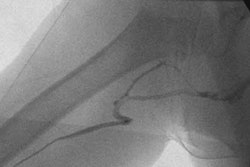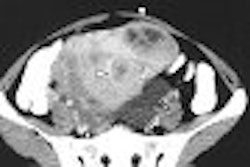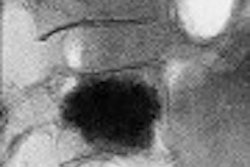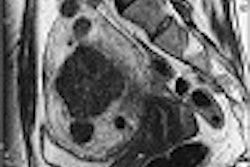CHICAGO - A single-center review of cases of carotid artery stenting to prevent stokes appears to show that the procedure can be performed safely and with similar success as surgical carotid endarterectomy, researchers reported Wednesday at the RSNA meeting.
"In our retrospective study, we treated 222 patients who had a total of 228 lesions that were corrected using carotid angioplasty with stent implacement," said Dr. Gianluca Piccoli, an interventional radiologist at the Santa Maria della Misericordia Hospital in Udine, Italy. "Our findings demonstrate that carotid angioplasty is a safe procedure, and the results are the same of surgical ones reported in literature." About 65 percent of the patients in the study were symoptomatic; 35 percent were asymptomatic, he said.
After three years, about 3% of patients had neurological complication, and about 4% of patients experienced restenosis with the stenting procedure, Piccoli said. Those figures are similar to the more invasive surgical operation, he added. Reporting on 178 of the patients in the series with at least six months follow-up, three people died -- two of nonrelated disease and one from a fatal contralateral stroke. Two other strokes considered minor in nature also occurred, he said.
"This study adds to the body of evidence that carotid stenting at this institution can be performed safely and with acceptable results," said Dr. Michael Brant-Zawadski, medical director of radiology at Hoag Memorial Hospital in Newport Beach, CA, and moderator of the press briefing at which Piccoli presented his data.
However, Brant-Zawadski said the new information is unlikely to settle the controversy over who should perform the procedures, nor whether the less-invasive, catheter-based procedure is superior in efficacy and in patient benefit to the open operation.
That controversy may be resolved, he said, by an ongoing study that randomized candidates to either the minimally invasive angioplasty and stent implacement, or open surgery.
Piccoli said all the procedures in the current series he reported were performed using an umbrella-like filter upstream of the lesion to collect clot debris that might cause additional damage in smaller blood vessels in the brain.
He stated that the stents used in the carotid arteries are similar to those used in coronary arteries, but are somewhat larger. He did not use drug-eluting stents because, he said, the low rate of restenosis -- 4% -- makes those more expensive stents less necessary in the carotid arteries. Piccoli also said that in his institutions decisions on whether to stent or to perform open surgery on patients is made by an interdisciplinary team of doctors, including surgeons, neurologists, and radiologists.
Brant-Zawadski applauded the multidisciplinary approach to the procedure. "Whoever does these procedures -- whether the surgeon or an interventional radiologist or a cardiologist -- it is imperative to think of the patients," he said. "I want to have a doctor present who knows how to deal with problems if they occur, especially someone familiar with brain vascular anatomy, who can correct something that occurs elsewhere in the brain."
By Edward Susman
AuntMinnie.com contributing writer
December 1, 2004
Related Reading
Classic 2D time-of-flight MRA aids severe carotid stenosis diagnosis, October 18, 2004
CMS finalizes coverage for carotid artery stenting, October 13, 2004
Carotid stenting safer than surgery for stroke prevention in diabetics, March 25, 2004
Carotid artery stenosis tied to cognitive decline, February 18, 2004
Copyright © 2004 AuntMinnie.com



















